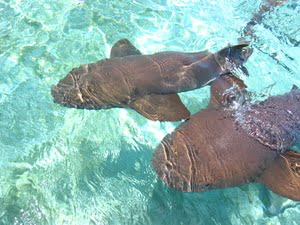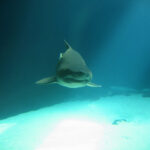20 Bizarre Facts About Sharks:
1. Sharks read the earth’s magnetic field like a map – the ocean current creates an electrical field, and so does every living thing. Sharks have electrical receptors, like pores, the lower jaw and snout. This sense is so powerful it can detect prey that’s completely buried in sand or mud on the ocean floor.
2. The male shark has two reproductive organs. He inserts one into a small slit in the female, wraps his tail around her, bites her back or fins. Mating is violent, and frequently inflicts serious wounds.
3. When two baby sand sharks are born, the larger one eats its sibling. This is called uterine cannibalism.
4. Nearly 2/3 of shark attack victims were spearfishing at the time. 14% were snorkeling, and 5% were scuba diving.
5. A shark’s liver makes up as much as 25% of its body weight. This helps sharks float better in the water because liver oil is less dense than water.
6. Shark fins and tails are shaped like aeroplane wings, which helps keep a shark lifted in the water. The heads on hammerhead sharks do the same thing.
7. A shark must never stop swimming, or it will sink. Most species must continually swim because they are heavier than water. Exceptions include sand sharks.
8. Shark skin feels smooth if it’s stroked from front to back but if it’s stroked from back to front, it is so rough it can scrape off human skin.
9. Small fish rub up against a shark because its rough skin helps scrape off parasites. When a shark is born, striped sharksuckers will immediately swim in and begin feeding on the birth sac.
10. Sharks have scales on their skin that are like tiny teeth. They are so good at making sharks swim smoothly through the water with little turbulence that engineers are copying the design of these scales to reduce turbulence in aircraft, submarines, and boats.
11. The ancient megatooth shark is said to have been 50 ft long and weighed 25-50 tonnes. Its open mouth spanned 6.5 feet., with teeth 7 inches long. That’s 3 times the size of the great white’s teeth.
12. Ratfish, or ghost sharks, have noses like rabbits and long spines along their dorsal fins. are rarely seen.
13. Sharks can see in nearly all directions because their eyes are set wide apart and they move their constantly move their heads from side to side.
14. Many experts believe sharks have such good night vision that they can hunt by starlight.
15. Great white sharks protect their eyes when they attack by rolling them up into their eye sockets before attacking.
16. Many sharks will swim hundreds of thousands of miles to find their breeding grounds.
17. 307 unborn baby sharks, or “pups,” were once found inside the uterus of a whale shark.
18. The spiny dogfish does is not ready to mate until she is 35 years old.
19. If a shark is turned over onto its back, it will become immobile and trance-like. It is called “tonic immobililty.”
20. Shark corneas have been used for human eye transplants.
Carwardine, Mark. “The Shark-Watcher’s Handbook: A Guide To Sharks and Where to See Them.” Princeton University Press, 2002.









